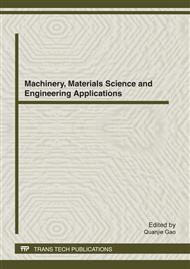[1]
ZHU Dangdang, LIU Lihua and OU Zhuguang. Simulation of a water-stop rubber s installation course with nonlinear FEM. Journal of Wuhan University of Hydraulic and Electric Engineering, Vol 37, No. 4(2004), pp.65-67.
Google Scholar
[2]
Stanistaw, Stupkiewicz and ArturMarciniszyn. Elastohydrodyn-amic lubrication and finite conguration changes in reciprocating elastomeric seals. Tribology International, Vol42, (2009), pp.615-627.
DOI: 10.1016/j.triboint.2008.08.008
Google Scholar
[3]
CHEN Guoding, Haiser H, Haas W and Lechner G. Analysis of Elastomeric O-Ring Seals Using the Finite Element Method. Mechanical Science and Technology. Vol. 19, No. 5 (2000), pp.740-744.
Google Scholar
[4]
Hu Dianyin, Wang Rongqiao, Ren Quanbin and Hong Jie. Finite element analysis of O-ring seal structure. Journal of Beijing University of Aeronautics and Astronautics. Vol31, No. 2 (2005), pp.255-260.
Google Scholar
[5]
Chung Kyun, Kim and Woo Jeon Shim. Analysis of contact force and thermal behaviour of lip seals. Tribology International, Vol. 30, No. 2(1996), pp.113-119.
DOI: 10.1016/0301-679x(96)00030-8
Google Scholar
[6]
Xie Jian, Tian Gui, Chen Jun. Finite Element Analysis of the Rubber Sealing Yx-ring in Hydraulic Cylinder. 2009 International Conference on Measuring Technology and Mechatronics Automation. 2009, pp.806-809.
DOI: 10.1109/icmtma.2009.409
Google Scholar
[7]
Hou Zhenxiu, Yu Zhiyang, Liu Yunmeng, Wang Lifeng and Wu fudi. Finite Element Analysis for Nitrile Rubber X-Ring Seal Structure. Aerospace Materials & Technology, Vol. 37, No. 6, (2007), pp.15-20.
Google Scholar
[8]
Chen Min, Tang Wencheng, Zhang Yifang and Zhao Chunhua. Finite Element Analysis of Hyperelastic Contact Problem in Valve Sealing Structure. China Mechanical Engineering, Vol. 18, No. 15, (2007), pp.1773-1775.
Google Scholar
[9]
LIU Jiangming. Analysis on Hydraulic Impact in hydraulic system of 300MN die forging hydraulic press [D]. Changsha, School of mechanical and electronic engineer, Central South University. (2010).
Google Scholar
[10]
Stanislaw Stupkiewicz, Artur Marciniszyn. Elastohydro-dynamic lubrication and finite configuration changes in reciprocating elastomeric seals. Tribology International, Vol. 42, (2009), pp.615-627.
DOI: 10.1016/j.triboint.2008.08.008
Google Scholar
[11]
ZHEN Mingjun, WANG Wenjing, CHEN Zhengnan and WU Lijun. Determination for mechanical constants of rubber Mooney-Rivlin model. Rubber Industry, Vol. 50, No. 8, (2003), pp.462-465.
Google Scholar
[12]
Peng Bing, Lin Shengyi and Xiang Yu. Nitrile rubber fabric to improve performance of seals. Lubrication Engineering. Vol32, No. 5 (2007), pp.174-175.
Google Scholar
[13]
He Tao. Instance tutorial of nonlinear finite element analysis based on ANSYS10. 0/LS-DYNA. Beijing: Mechanical Industry Press, (2007).
Google Scholar


